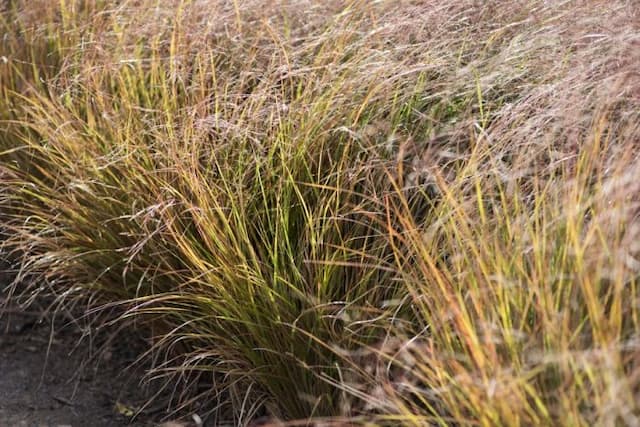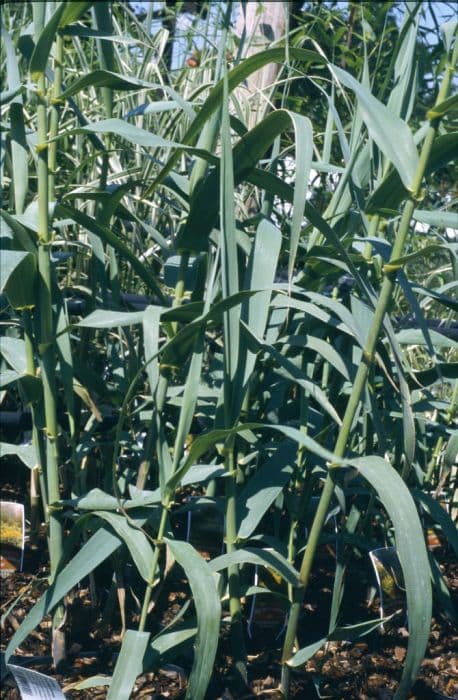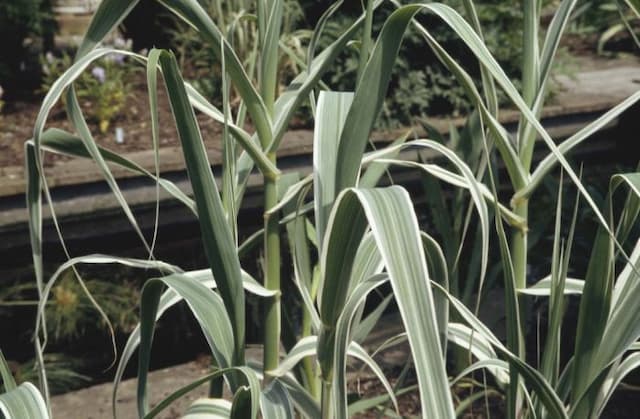Giant Feather Grass Stipa gigantea

ABOUT
Stipa gigantea, commonly known as giant feather grass, has a distinctive and elegant appearance that makes it a favorite in many gardens. This ornamental grass is characterized by its arching, fountain-like clumps of narrow, green foliage which provides a graceful backdrop to its most striking feature: the large, airy panicles of shimmering flower spikes. These spikes emerge looking like slender, silvery rods that catch the light, transforming into a golden hue as they mature through the season. The flowers sway gracefully atop stiff stems, creating a visual spectacle that resembles a cloud of golden mist or a spray of fine, feathery wands. The overall texture of giant feather grass is fine and hair-like, lending a softness to the landscape despite its robust form. The color of the foliage can be described as a deep, lush green which contrasts beautifully with the silvery to golden tones of the tall, billowing flower heads. This plant manages to capture both a sense of delicacy and a striking presence, making it a versatile choice for various garden aesthetics.
About this plant
 Names
NamesSynonyms
Giant Feather Grass, Golden Oats
Common names
Celtica gigantea, Macrochloa gigantea, Stipa gigantea var. genuina, Stipa gigantea var. glabrata, Stipa gigantea var. laxa.
 Toxicity
ToxicityTo humans
Giant feather grass is not known to be toxic to humans. There are no well-documented cases of poisoning from ingesting any part of this plant, and no specific symptoms of poisoning associated with it. It is generally considered safe with respect to human toxicity.
To pets
Giant feather grass is also not recognized as being toxic to pets. It does not contain any known toxic compounds that would pose a risk if ingested by animals such as dogs or cats. Therefore, there are no specific symptoms or consequences associated with pets ingesting this ornamental grass.
 Characteristics
CharacteristicsLife cycle
Perennials
Foliage type
Deciduous
Color of leaves
Green
Flower color
Gold
Height
6 feet (1.8 meters)
Spread
4 feet (1.2 meters)
Plant type
Grass
Hardiness zones
7
Native area
Spain
Benefits
 General Benefits
General Benefits- Ornamental Appeal: Giant Feather Grass adds visual interest to gardens with its tall, graceful stems and feathery flower heads that catch the light and move with the breeze.
- Low Maintenance: Once established, it requires minimal care, making it an excellent choice for gardeners seeking low-maintenance landscaping options.
- Drought Tolerance: Native to dry climates, it is well-suited for water-wise gardens, requiring little irrigation once it’s well-rooted.
- Wildlife Attraction: The flowering spikes attract a variety of insects, while the seeds provide food for birds during the fall and winter months.
- Seasonal Interest: It provides year-round interest with green foliage in spring and summer, golden brown inflorescences in the fall, and striking seed heads that persist through winter.
- Architectural Structure: Its towering height and strong vertical lines can serve as a focal point or provide a backdrop for other plants in a garden design.
- Wind and Sound Buffer: The dense clumps of foliage and tall stems can act as a natural windbreak and help reduce noise pollution in garden spaces.
 Medical Properties
Medical PropertiesThis plant is not used for medical purposes.
 Air-purifying Qualities
Air-purifying QualitiesThis plant is not specifically known for air purifying qualities.
 Other Uses
Other Uses- Stipa gigantea, commonly known as giant feather grass, can be used as a privacy screen in gardens due to its tall stature and dense foliage.
- Its tall, elegant stems are often used in dried floral arrangements and can add height and texture to bouquets or indoor displays.
- The plant can be used as a natural windbreak in landscaping, thanks to its height and clumping growth habit.
- Giant feather grass can be employed in erosion control to stabilize soils on slopes and embankments due to its extensive root system.
- When planted in mass, it creates a habitat for wildlife, providing shelter and food for birds and small mammals.
- The seeds of giant feather grass can be collected and used artistically in crafts for decoration and texture.
- Used as a living sculpture in the garden, its imposing form and golden panicles create visual interest, especially when backlit by the sun.
- It serves as an acoustic barrier; its dense growth can help muffler noise pollution when planted along roadsides or between properties.
- As part of a xeriscape garden, giant feather grass can help reduce the need for watering due to its drought tolerance once established.
- In photography, the distinctive appearance of giant feather grass provides a compelling subject for garden and nature photographers looking to capture its movement and structure.
Interesting Facts
 Feng Shui
Feng ShuiThe plant Giant Feather Grass is not used in Feng Shui practice.
 Zodiac Sign Compitability
Zodiac Sign CompitabilityThe plant Giant Feather Grass is not used in astrology practice.
 Plant Symbolism
Plant Symbolism- Grace: The slender and tall structure of Stipa gigantea, commonly known as Giant Feather Grass, symbolizes natural grace and elegance.
- Movement: Its wispy and flowing seed heads that sway with the wind represent freedom and the beauty of movement.
- Resilience: As a hardy plant that can withstand tough conditions, Giant Feather Grass signifies strength and the ability to adapt and survive challenges.
 Water
WaterFor the Giant Feather Grass, it is essential to water deeply but infrequently to encourage deep root growth. During the growing season in spring and summer, watering once a week with about 1 to 1.5 inches of water is typically sufficient, depending on the weather conditions. Reduce the frequency to every two to three weeks in cooler temperatures. It's important to let the soil dry out between waterings to avoid overwatering. When established, this ornamental grass is quite drought-tolerant, and thus, it doesn't need to be watered as frequently. The total amount should roughly be about a half gallon per square foot per month during active growth.
 Light
LightGiant Feather Grass thrives in full sun conditions. It should be planted in a spot where it can receive at least six hours of direct sunlight each day. This grass does not grow well in shaded areas, so it's best to avoid spots that are overshadowed by trees or buildings. The ideal location is an open area with clear access to sunlight throughout the day.
 Temperature
TemperatureGiant Feather Grass prefers temperate conditions and handles a wide range of temperatures. It can survive in temperatures as low as 20 degrees Fahrenheit and as high as 90 degrees Fahrenheit. The ideal temperature range for this plant is between 60 and 75 degrees Fahrenheit. Extreme temperatures might lead to poor growth or damage to the plant.
 Pruning
PruningPruning Giant Feather Grass should be done to remove dead foliage and to maintain its tidy appearance. It's best to prune in late winter or early spring before new growth starts. This can be done by cutting the grass back to about 6 inches from the ground. Pruning is typically only needed once a year. The best time to prune is just before the new growth commences, as this allows the plant to focus its energy on producing fresh, vibrant foliage.
 Cleaning
CleaningNot needed
 Soil
SoilGiant Feather Grass thrives in a well-drained soil mix with a pH ranging from neutral to slightly acidic. A mix of two parts garden soil, one part sand, and one part organic compost is ideal, ensuring good drainage and fertility. Adjusting the soil pH to between 6.0 and 7.0 will support healthy plant growth.
 Repotting
RepottingGiant Feather Grass is not commonly grown as a potted plant and typically does not require repotting. It is a perennial grass best planted directly in the ground where it can develop its deep roots without disturbance.
 Humidity & Misting
Humidity & MistingGiant Feather Grass prefers a low to moderate humidity level, typical of its natural open grassland habitat. It is quite tolerant of dry conditions once established and does not require high humidity to thrive.
 Suitable locations
Suitable locationsIndoor
Ensure full sun, well-drained soil, and avoid overwatering.
Outdoor
Plant in full sun, well-draining soil; tolerate drought.
Hardiness zone
7-10 USDA
 Life cycle
Life cycleGiant Feather Grass, commonly known as Stipa gigantea, begins its cycle as a seed, which when sown in fertile, well-drained soil and with sufficient warmth, will germinate. The seedling emerges and develops into a tufted clump with narrow, arching leaves. As the plant matures, in late spring to early summer, it sends up tall flower spikes that can reach up to 2.5 meters in height, with airy, oat-like flower heads that mature to a golden brown. After pollination, these flowers set seed by late summer or autumn, which can be dispersed by wind or collected for propagation. Throughout the growing season, Stipa gigantea requires minimal care, being drought-tolerant and generally resistant to pests and diseases. In winter, the foliage and spent flower spikes provide structural interest in the landscape and should be cut back in early spring to make way for fresh growth.
 Propogation
PropogationPropogation time
Spring to early summer
Giant feather grass, or Stipa gigantea, is best propagated through seed. The ideal time for sowing the seeds is in spring after the last frost or in autumn, capitalizing on the cooler temperatures that support germination. To propagate by seed, simply scatter them over a well-draining soil mixture and lightly cover with soil, no more than 1/8 inch (approximately 3 mm) deep. The soil should be kept moist but not saturated until germination occurs. Seeds will typically germinate in 2 to 3 weeks when maintained at a temperature around 70 degrees Fahrenheit (approximately 21 degrees Celsius). Thin the seedlings as necessary, and once they're strong enough and the threat of frost has passed, they can be transplanted outdoors to their permanent position in the garden.









